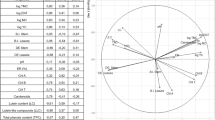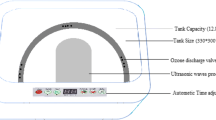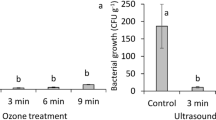Abstract
Effect of ultrasonication (40 kHz) to enhance low concentration electrolyzed water (LcEW) efficacy for microbial decontamination on lettuce leaves was investigated. Lettuce was separately treated with LcEW, ultrasonication, LcEW combined with ultrasonication, LcEW followed by ultrasonication, and ultrasonication followed by LcEW for 1, 3, and 5 min for each step at room temperature. The highest reduction (2.3 log CFU/g) in total bacteria count (TBC) was resulted from ultrasonication followed by LcEW. Subsequently, the effect of temperature was studied resulting in 2.6 and 3.18 log CFU/g reduction of TBC and Escherichia coli O157:H7 respectively, in 3 min ultrasonication followed by 3 min LcEW treatment at 40°C. This optimum treatment also prevented lettuce from reaching 7.0 log CFU/g in TBC until the end of the 6 day storage at 10°C. Therefore, this newly developed approach may result in improved microbiological safety and enhanced shelf life of produce.
Similar content being viewed by others
References
Fain AR. A review of the microbiological safety of fresh salads. Dairy Food Environ. Sanit. 16(3): 146–149 (1996)
Ajlouni S, Sibrani H, Premier R, Tomkins B. Ultrasonication and fresh produce (Cos lettuce) preservation. J. Food Sci. 71: M62–M68 (2006)
Martin-Belloso O, Sobrino-Lopez A. Combination of pulsed electric fields with other preservation techniques. Food Bioprocess. Technol. 4: 954–968 (2011)
Nathan R. American seeds suspected in Japanese food poisoning epidemic. Nat. Med. 7: 705–706 (1997)
Del Rosario BA, Beuchat LR. Survival and growth of enterohemorrhagic Escherichia coli O157:H7 in cantaloupe and watermelon. J. Food Protect. 58: 105–107 (1995)
[CDC] Centers For Disease Control And Prevention. 2006. Available from: http://www.cdc.gov/foodborne/ecolispinach/100606.htm. Accessed Jan 10, 2012.
[WHO] WORLD HEALTH ORGANIZATION. 2011. Available from: http://www.euro.who.int/en/what-we-do/health-topics/diseaseprevention/food-safety/publications/2011/a-public-health-review-ofthe-enterohaemorrhagic-escherichia-coli-outbreak-in-germany. Accessed Jan 16, 2012.
Huang TS, Xu C, Walker K, West P, Zhang S, Weese J. Decontamination efficacy of combined chlorine dioxide with ultrasonication on apples and lettuce. J. Food Sci. 71: M134–M139 (2006)
Ruiz-Cruz S, Acedo-Félix E, Díaz-Cinco M, Islas-Osuna MA, González-Aguilar GA. Efficacy of sanitizers in reducing Escherichia coli O157:H7, Salmonella spp. and Listeria monocytogenes populations on fresh-cut carrots. Food Control 18: 1383–1390 (2007)
Al-Haq MI, Sugiyama J, Isobe S. Applications of electrolyzed water in agriculture and food industries. Food Sci. Technol. Res. 11: 135–150 (2005)
Rahman SME, Ding T, Oh DH. Inactivation effect of newly developed low concentration electrolyzed water and other sanitizers against microorganisms on spinach. Food Control 21: 1383–1387 (2010)
Klaiber RG, Baur S, Wolf G, Hammes WP, Carle R. Quality of minimally processed carrots as affected by warm water washing and chlorination. Innovat. Food. Sci. Emerg. 6: 351–362 (2005)
Chaudry MA, Bibi N, Khan M, Badshah A, Qureshi MJ. Irradiation treatment of minimally processed carrots for ensuring microbiological safety. Radiat. Phys. Chem. 71: 169–173 (2004)
Cao W, Zhu ZW, Shi ZX, Wang CY, Li BM. Efficiency of slightly acidic electrolyzed water for inactivation of Salmonella enteritidis and its contaminated shell eggs. Int. J. Food Microbiol. 130: 88–93 (2009)
Guentzel JL, Lam KL, Callan MA, Emmons SA, Durham VL. Reduction of bacteria on spinach, lettuce, and surfaces in food service areas using neutral electrolyzed oxidizing water. Food Microbiol. 25: 36–41 (2008)
Hamre D. The effect of ultrasonic waves upon Klebsiella pneumoniae, Saccharomyces cerevisiae, Miyagawanella felis, and influenza virus. Squibb. Inst. Med. Res. 57: 279–295 (1948)
Zhou B, Feng H. Luo Y. Ultrasound enhanced sanitizer efficacy in reduction of Escherchia coli O157:H7 population on spinach leaves. J. Food Sci. 74: M308–M313 (2009)
Mizrach A, Galili N, Rosenhouse G. Determining quality of fresh products by ultrasonic excitation. Food Technol. -Chicago 48(12): 68–71 (1994)
Detwiler MS. Ultrasonic cleaning in the hospital. J. Healthcare Mat. Mgt. 7(3): 46–50 (1989)
Lillard HS. Decontamination of poultry skin by sonication. Food Technol.-Chicago 4(12): 72–73 (1994)
Sams AR. Feria R. Microbial effects of ultrasonication of broiler drumstick skin. J. Food. Sci. 56: 247–248 (1991)
Garcia ML, Burgos J, Sanz B, Ordonez JA. Effect of heat and ultrasonic waves on the survival of two strains of Bacillus subtilis. J. Appl. Bacteriol. 67: 619–628 (1989)
Barbosa-canovas G. Key goals of emerging technologies for inactivating bacteria. Food Saf. Mag. 34: 36–42 (2002)
Ellery WN, Schleyer MH. Comparison of homogenization and ultrasonication as techniques in extracting attached sedimentary bacteria. Mar. Ecol. -Prog. Ser. 15: 247–250 (1984)
Piyasena P, Mohareb E, Mckellar RC. Inactivation of microbes using ultrasound “a review”. Int. J. Food Microbiol. 87: 207–216 (2003)
Rodgers SL, Ryser ET. Reduction of microbial pathogens during apple cider production using sodium hypochlorite, copper ion, and sonication. J. Food Protect. 67: 766–771 (2004)
Scouten AJ, Beuchat LR. Combined effects of chemical, heat, and ultrasound treatments to kill Salmonella and Escherichia coli O157:H7 on alfalfa seeds. J. Appl. Microbiol. 92: 668–674 (2002)
Yuk HG, Yoo MY, Yoon JW, Moon KD, Marshall DL, Oh DH. Effect of combined ozone and organic acid treatment for control of Escherichia coli O157:H7 and Listeria monocytogenes on lettuce. J. Food Sci. 71: M83–M87 (2006)
Sengun IY, Karapinar M. Elimination of Yersinia enterocolitica on carrots (Daucus carota L.) by using household sanitizers. Food Control 16: 845–850 (2005)
Ugarte-Romero E, Feng H, Martin SE. Inactivation of Shigella boydii 18 IDPH and Listeria monocytogenes Scott A with power ultrasound at different acoustic energy densities and temperatures. J. Food Sci. 72: C103–C107 (2007)
Seymour IJ, Burfoot D, Smith RL, Cox LA, Lockwood A. Ultrasound decontamination of minimally processed fruits and vegetables. Int. J. Food Sci. Tech. 37: 547–557 (2002)
Nan S, Li Y, Li B, Wang C, Cui X, Cao W. Effect of slightly acidic electrolyzed water for inactivating Escherichia coli O157:H7 and Staphylococcus aureus analyzed by transmission electron microscopy. J. Food Protect. 73: 2211–2216 (2010)
Ding T, Rahman SME, Oh DH. Inhibitory effects of low concentration electrolyzed water and other sanitizers against foodborne pathogens on oyster mushroom. Food Control 22: 318–322 (2010)
Rahman SME, Ding T, Oh DH. Effectiveness of low concentration electrolyzed water to inactivate foodborne pathogens under different environmental conditions. Int. J. Food Microbiol. 139: 147–153 (2010)
Fan X, Annous BA, Beaulieu JC. Sites JE. Effect of hot water surface pasteurization of whole fruit on shelf life and quality of fresh-cut cantaloupe. J. Food Sci. 73: M91–M98 (2008)
Alegria C, Pinheiro J, Gonçalves EM, Fernandes I, Moldão M, Abreu M. Evaluation of a pre-cut heat treatment as an alternative to chlorine in minimally processed shredded carrot. Innovat. Food Sci. Emerg. 11: 155–161 (2010)
Gómez-López VM, Devlieghere F, Ragaert P, Debevere J. Shelf life extension of minimally processed carrots by gaseous chlorine dioxide. Int. J. Food Microbiol. 116: 221–227 (2007)
Koseki S, Yoshida K, Kamitani Y, Isobe S, itoh K. Effect of mild heat pre-treatment with alkaline electrolyzed water on the efficacy of acidic electrolyzed water against Escherichia coli O157:H7 and Salmonella on lettuce. Food Microbiol. 21: 559–566 (2003)
Author information
Authors and Affiliations
Corresponding author
Rights and permissions
About this article
Cite this article
Forghani, F., Rahman, S.M.E., Park, MS. et al. Ultrasonication enhanced low concentration electrolyzed water efficacy on bacteria inactivation and shelf life extension on lettuce. Food Sci Biotechnol 22, 131–136 (2013). https://doi.org/10.1007/s10068-013-0018-8
Received:
Revised:
Accepted:
Published:
Issue Date:
DOI: https://doi.org/10.1007/s10068-013-0018-8




